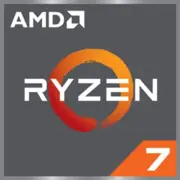AMD Ryzen 7 5800X

AMD Ryzen 7 5800X in 2025: Is It Worth Getting the Zen 3 Legend?
April 2025
Key Specifications: Architecture and Performance
The AMD Ryzen 7 5800X, released in 2020, remains a popular choice for budget builds and upgrades. Its Zen 3 architecture (codename Vermeer) is built on 7nm TSMC technology, ensuring high energy efficiency and transistor density.
- 8 cores and 16 threads with a base clock of 3.8 GHz and a maximum of 4.7 GHz;
- 32 MB L3 cache — a record amount for its time;
- TDP of 105W, which requires good cooling;
- Support for PCIe 4.0 (24 lanes).
Performance in Geekbench 6 tests (2174 / 10282 in Single/Multi-Core) shows that even in 2025, the chip handles modern games and applications well. For example, in Cyberpunk 2077: Phantom Liberty (2024) at 1440p resolution with an RTX 4070, the processor delivers stable 90–110 FPS.
Key Features:
- Precision Boost 2 — automatic overclocking based on workload;
- Smart Access Memory — accelerates access to video memory (requires pairing with an AMD GPU);
- No integrated graphics — a discrete graphics card is needed.
Compatible Motherboards: AM4 Socket and Choosing Wisely
The Ryzen 7 5800X uses the AM4 socket, which by 2025 has given way to AM5, but remains relevant for budget PCs.
Recommended Chipsets:
- B550 ($100–150): An optimal choice with PCIe 4.0 support and USB 3.2 Gen2. Examples: MSI B550 Tomahawk, ASUS ROG Strix B550-F.
- X570 ($150–200): Advanced overclocking capabilities (for example, Gigabyte X570 Aorus Elite).
Important:
- BIOS update is required for Ryzen 5000 compatibility (AGESA version 1.2.0.7 or newer).
- A520 motherboards ($70–100) are suitable for basic tasks but lack PCIe 4.0 and overclocking.
Supported Memory: DDR4 and Tuning Tips
The processor works with only DDR4 (DDR5 is not supported).
Recommendations:
- Optimal frequency: 3600 MHz (best price/performance ratio).
- It’s better to use two modules (e.g., 2×16 GB) for dual-channel mode.
- Compatible models: Crucial Ballistix 3600 CL16, G.Skill Trident Z Neo.
Example: With 32 GB of DDR4-3600, the Ryzen 7 5800X shows an up to 12% performance gain in multithreaded tasks (Blender, Premiere Pro) compared to DDR4-3200.
Power Supply: Power Calculation
With a TDP of 105W and peak consumption of up to 142W (OCCT tests), the processor requires:
- At least 550W for systems with RTX 4060 level GPU;
- 650–750W for RTX 4070 Ti / RX 7700 XT.
Tips:
- Choose a PSU with an 80 Plus Gold certification (e.g., Corsair RM650x or Seasonic Focus GX-750).
- Avoid cheap noname units — they may operate unstably under load.
Pros and Cons of the Ryzen 7 5800X
Strengths:
- High single-thread performance — ideal for gaming;
- Energy efficiency (7nm vs. 10nm Intel 12th Gen);
- PCIe 4.0 support for fast NVMe drives.
Weaknesses:
- No support for DDR5 and PCIe 5.0;
- Requires a powerful cooler (the stock cooler is insufficient);
- Price in 2025 ($250–300) competes with new models (e.g., Ryzen 5 8600G at $299).
Use Cases: Who Is It Suitable For?
1. Gamers: In games like Apex Legends or Call of Duty: Warzone, the processor doesn’t create a bottleneck even for RTX 4080 at 1440p.
2. Work Tasks: 8 cores are sufficient for 4K video editing in DaVinci Resolve and 3D rendering in Blender.
3. Streaming: Paired with NVENC (Nvidia) or AMF (AMD), encoding goes smoothly without FPS loss.
Real Example: A post-production studio uses the Ryzen 7 5800X with an RTX 3060 for rendering short clips — processing time for a 10-minute 4K video is about 25 minutes.
Comparison with Competitors
- Intel Core i5-13600K ($280): 14 cores (6P+8E), DDR5 support. Better in multithreading tasks (+18% in Cinebench R23), but motherboards are more expensive (LGA 1700).
- Ryzen 7 7700X ($320): 8 Zen 4 cores, DDR5, PCIe 5.0. 25% faster in single-threaded tests but requires AM5 and DDR5.
- Ryzen 5 8600G ($299): 6 Zen 4 cores + integrated RDNA 3 graphics. Falls behind in multithreading but is convenient for compact PCs.
Conclusion: The 5800X wins in platform pricing (AM4 is cheaper than AM5/LGA 1700) but loses in “futuristic” features.
Building Tips
1. Cooling: Coolers like Noctua NH-U12S ($70) or AIO coolers like Deepcool LS520 ($90).
2. Case: At least 2 intake fans (e.g., Fractal Design Meshify C).
3. Storage: NVMe PCIe 4.0 (e.g., Samsung 980 Pro 1TB) for maximum speed.
4. BIOS: Update to the latest version before installing the processor.
Final Conclusion: Who Is the Ryzen 7 5800X Suitable for in 2025?
This processor is a choice for:
- Gamers looking to save on the platform (AM4 + DDR4);
- Owners of older AM4 PCs (upgrading from Ryzen 5 2600 or similar);
- Budget workstations where stability is important.
Why not to buy: If you plan to transition to DDR5 or PCIe 5.0, it's better to look at Ryzen 7000/8000 or Intel 14th generation.
Price: $250–300 (new, April 2025) makes the 5800X a worthwhile option for those not chasing the latest technologies but valuing proven performance.
Basic
CPU Specifications
Memory Specifications
GPU Specifications
Miscellaneous
Benchmarks
Compared to Other CPU
Share in social media
Or Link To Us
<a href="https://cputronic.com/index.php/cpu/amd-ryzen-7-5800x" target="_blank">AMD Ryzen 7 5800X</a>